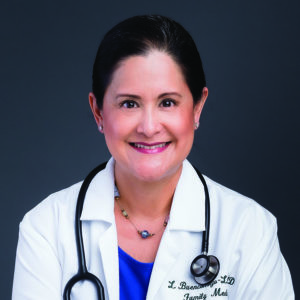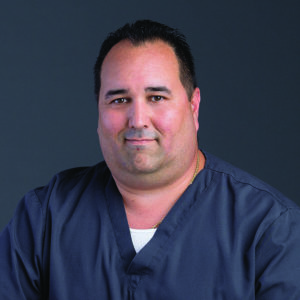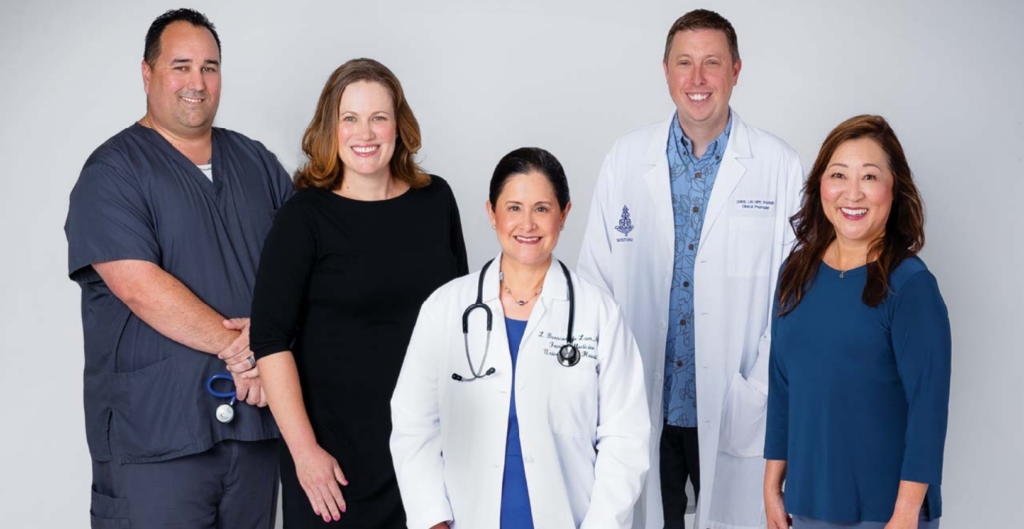A New Approach to Improve Health and Health Care in Hawai‘i and the Pacific
While Hawai‘i is often ranked the healthiest state in the nation, many health problems persist. There is a significant shortage of health professionals, including certified nursing assistants, phlebotomists, rehabilitation professionals, nurses, and physicians, which is often worse in rural areas. Native Hawaiians, Pacific Islanders and other minorities face significant health disparities. Hawai‘i’s children have the worst tooth decay in the nation. Hawai‘i also has a high prevalence of people with behavioral health issues, which contributes to the state’s homelessness problem.

To improve health in Hawai‘i, it is important to understand the many determinants of individual and community health as outlined by the Office of Disease Prevention and Health Promotion. These include individual lifestyles and decisions (i.e., smoking, exercise, nutrition); individual genetics (i.e., carrying the BRCA1 gene); social and environmental factors of health (i.e., walkability, economic opportunity, community violence); health services (i.e., health insurance, access to health providers); and policymaking (i.e., clean air laws, tobacco prevention laws).
While it would be difficult for any organization to address all of these health factors, the University of Hawai‘i System (UH System) has specific resources that can be brought to bear to address many of these health determinants and improve the health of our community. As the state’s sole public higher education institution, the UH System contains strong health sciences programs—including medicine, nursing, pharmacy, social work, public health, allied health, and the University of Hawai‘i Cancer Center—that collectively play an essential role in educating Hawai‘i’s health workforce and addressing the health challenges facing Hawai‘i and the Pacific.
“UHealthy Hawai‘i is the UH System’s new initiative to leverage these UH health sciences programs to improve health and health care in Hawai‘i and the Pacific,” said UH President David Lassner. “As one my top priorities, the UHealthy Hawai‘i initiative aims to address the following four key areas: 1) ensuring a robust statewide health workforce; 2) discovering and innovating to improve and extend lives; 3) promoting healthier families and communities; and 4) advancing health in all policies.”

Led by UH Director of Health Science Policy Aimee Grace, UHealthy Hawai‘i was developed through listening sessions with leaders and faculty across the UH health sciences programs. The effort has involved seeking feedback from key individuals about opportunities for strengthening the UH programs while helping to improve health and health care in the state and Asia-Pacific Rim. Following months of listening sessions, a brainstorming session with leaders of UH health sciences programs, UH System vice presidents, and President Lassner in fall 2018 led to the development of the initiative’s name and its four primary areas of focus.
The first area of focus in UHealthy Hawai‘i is ensuring a robust statewide health workforce. UH has been a key partner in the Healthcare Workforce Initiative, which is led by the Healthcare Association of Hawai‘i and is an integral part of the Healthcare Sector Partnership (a convening led by UH and the Chamber of Commerce Hawai‘i to bring together industry and education leaders to address health workforce challenges). The Healthcare Workforce Initiative is working to align the state health care industry’s needs in terms of critical job shortages with the educational offerings provided by the state’s universities. Another goal is to ensure that UH students have enough clinical training placement sites in the community at industry sites to fulfill their clinical training requirements.
“Our goal is that optimal alignments between the healthcare industry and academia will not only better meet the health provider needs in Hawai‘i, but provide meaningful and good-paying job opportunities for students across our state. Healthcare provides multiple career ladder opportunities,” added Hilton Raethel, President and CEO of the Healthcare Association of Hawai‘i.
The UHealthy Hawai‘i initiative also has a Strategic Action Plan for Optimizing Hawai‘i’s Health Workforce with a matrix of possible solutions to Hawai‘i’s health workforce challenges. With its public-private partners, the UH System looks forward to proactively addressing these challenges through action teams, while seeking key resources. State of Hawai‘i Lieutenant Governor Josh Green, who has been working with the UHealthy Hawai‘i initiative, said “I believe the team that has come together for the UHealthy Hawai‘i Initiative has the capacity to crack the code on our provider shortage. We just need the political will to get it done.”

UHealthy Hawai‘i is also looking to creative solutions to meet the needs of today’s health workforce. For example, UH Hilo’s Daniel K. Inouye College of Pharmacy graduates dozens of pharmacists per year. While pharmacists are often thought of as dispensing pills at Longs Drugs or Walgreens, they are also integral members of the health care team and provide high-quality care to high-risk, high-cost patients with chronic diseases in terms of medication management, identifying drug-drug interactions and side effects, and providing patient education.
“If more pharmacists were utilized to care for high-risk patients, their primary care providers would have more availability to see more patients, thus providing more patient care access,” said Grace. “UHealthy Hawai‘i aims to better integrate pharmacists into clinical practices to provide excellent patient care while potentially lowering costs and addressing provider shortage issues.”
The second area of focus in UHealthy Hawai‘i is discovery and innovation. The initiative intends to build on UH’s legacy of high-quality, culturally-sensitive, successful research and innovation to improve and extend lives by discovering solutions to locally-relevant and world-changing problems, especially discoveries that aid Hawai‘i’s multi-ethnic population, communities indigenous to the Pacific, and the increasingly multi-cultural population of the continental United States. Doing so involves recruiting more faculty with the ability to bring in funding from the National Institutes of Health; focusing research on areas of importance to the Native Hawaiian and Pacific Islander community, including heart disease, cancer, diabetes and stroke; strengthening relationships between students and faculty on research endeavors; partnering with state agencies to align research needs with appropriate expertise; and increasing cybersecurity for big data analyses.

“UHealthy Hawai‘i intends to foster innovation and product development in the area of natural products by exploring the creation of a collaboration between the UH Cancer Center, John A. Burns School of Medicine, College of Tropical Agriculture and Human Resources, and more units across the UH System to capitalize on Hawai‘i’s strengths in this area,” said UH Vice President for Research and Innovation Vassilis L. Syrmos, whose office is spearheading the UHealthy Hawai‘i initiative. “Hawai‘i’s unique resources in terms of flora, fauna, and marine life are well-suited for innovative researchers and entrepreneurs that seek to elucidate novel treatments for diseases.”
The third area of focus in UHealthy Hawai‘i is promoting healthier families and communities. Some key potential projects in this area include championing prevention and wellness activities to improve community and population health; establishing a healthy aging initiative; addressing social and environmental determinants of health and tackling persistent health disparities, including in Native Hawaiian and Pacific Islander populations; fostering further global health engagement, especially in the Asia-Pacific region; and promoting healthy family relationships and social connections that support emotional wellness and resilience.
Lastly, UHealthy Hawai‘i intends to drive and advance health in all policies by applying UH’s analytical and educational leadership to address pressing health policy and economic issues in the state, the Pacific and nationwide. Under consideration is the development of a health policy institute, which would have expertise in data and analytics; education and training; and policy development, as well as serve as a convener of partnerships in health policy.

Overall, UHealthy Hawai‘i aims to align UH System’s health sciences programs toward a common purpose: improving health and health care in the state of Hawai‘i and the Pacific. Forging meaningful partnerships is critical to the accomplishment of these goals. UHealthy Hawai‘i has numerous community partners to date, including State partners (Hawai‘i State Department of Health, Med-QUEST, Office of the Lieutenant Governor Josh Green); health systems (Hawai‘i Pacific Health, The Queen’s Health System, Kaiser Permanente, Adventist Health Castle, Rehab Hospital of the Pacific, Hawai‘i Health Systems Corporation, VA Pacific Islands Health Care System); insurers (HMSA, Kaiser Permanente); associations (Healthcare Association of Hawai‘i, Hawai‘i Medical Association, Hawai‘i State Rural Health Association, Hawai‘i Primary Care Association, Papa Ola Lokahi, American College of Physicians-Hawai‘i Chapter, American Academy of Pediatrics-Hawai‘i Chapter); community advocacy organizations (Hawai‘i Appleseed, NAMI Hawai‘i, Kokua Mau, Hawai‘i Parkinson Association, YMCA Hawai‘i); and the Chamber of Commerce Hawai‘i.
“UHealthy Hawai‘i is the health policy think tank our state has needed for some time now, and the Department of Health is enthusiastic in our support,” said Bruce S. Anderson, director of the Hawai‘i State Department of Health. “Dr. Grace is the ideal leader to guide the UH System’s considerable resources into something greater than the sum of its parts. There is a recognition that a person’s ZIP code—where they live, learn, work, and play—is a stronger predictor of health than their genetic code and our current systems of care are not up to the task of addressing this understanding. UHealthy Hawai‘i’s focus on developing workforce, innovation, prevention, and impactful health policy are the essential building blocks we have to put in place today to have the health outcomes we want tomorrow.”
With further support and buy-in from federal, state, and local government partners, as well as other community partners, UHealthy Hawai‘i’s future for making a difference in health and health care for the people of Hawai‘i and the Pacific is definitely looking brighter.

